- Bernard Preston homepage
- Olives
Preserving olives
Preserving olives is fun to do and not arduous, but attention to detail is important and you must have access directly to the farmer to make it affordable. Is your well-being important enough that you will turn the television off and make the time?
Like I said it is not arduous, but you do have to examine each an every olive to see if it has been damaged or stung by insects; that does take time. About four-hours to process 60kg of olives in the 2020 season, and get them into brine.
This year we are trying a different technique for the first time; scroll down to the bottom of the page. It is the better way I think.
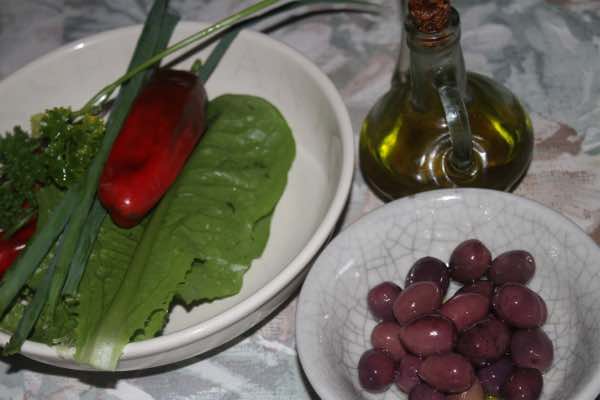
I will be telling you how much time, down the road, and how many ball-games you will be missing.
Last year we purchased 40 kg of black-olives directly from the farmer. If you want to be really sure, go and pick them yourself; it would make a lovely outing for the family to a Little Karoo farm.
Pick your own; PYO.
They definitely must be under water within 24-hours, and preferably 12. It would seem there are three ways of preserving olives after they have been in brine for several months.
- The Italian way. Just leave them in brine and do nothing more; enjoy them whilst there is still a distinct bitterness.
- The Greek way. Soak them in water for one-day and then preserve them in olive oil.
- The Cape way. Put them into a hot-vinegar solution. This way they will keep for several years without going mushy.
This page was last updated by Bernard Preston on the 5th September, 2021.
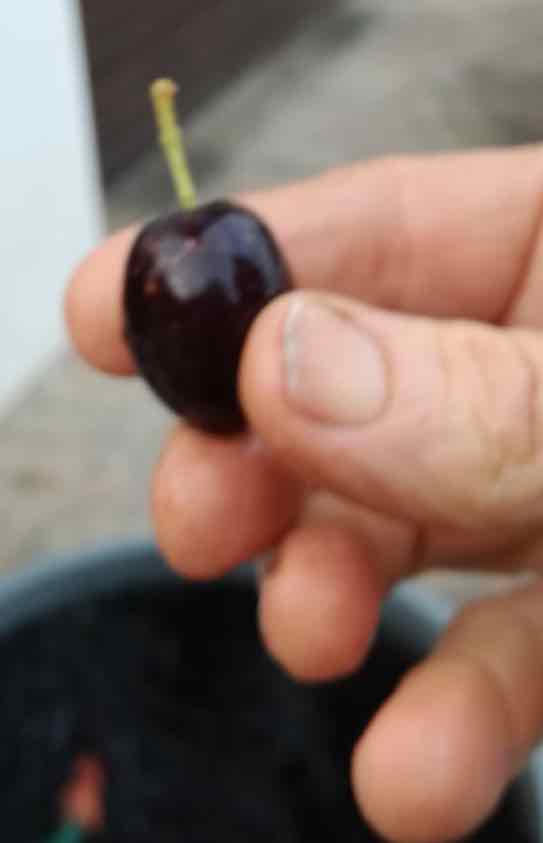
Preserving black olives
This is an especially good recipe for preserving Mission black-olives, but you probably cannot be that choosy. Take whatever you can get.
Use only freshly-picked olives; it is not worth spending this amount of time on second rate fruit. Once bruised or damaged, oxidation sets in. Remember, you will not be enjoying them for perhaps four or more months. Choose only the best.
For a good oil you do not want black olives because they are too ripe, but for those lusting for the whole fruit they are perfect once they are plump but still firm, and a shiny dark-colour.
And here is an update on this subject. Below we have advocated changing the brine every two-months; this year ours started to go soft before the bitterness had been removed.
From 2021 we will start changing the brine every six instead of eight-weeks; a small cost, a bit of extra work, and a better chance of getting prime firm but not bitter olives.
"A good-olive is something that is well balanced. It is not overly bitter, nor particularly pungent.
The fruit, bitterness and pungency are all in harmony."
- Jason de Beer, Morgenster.
Step 1: Wash and soak
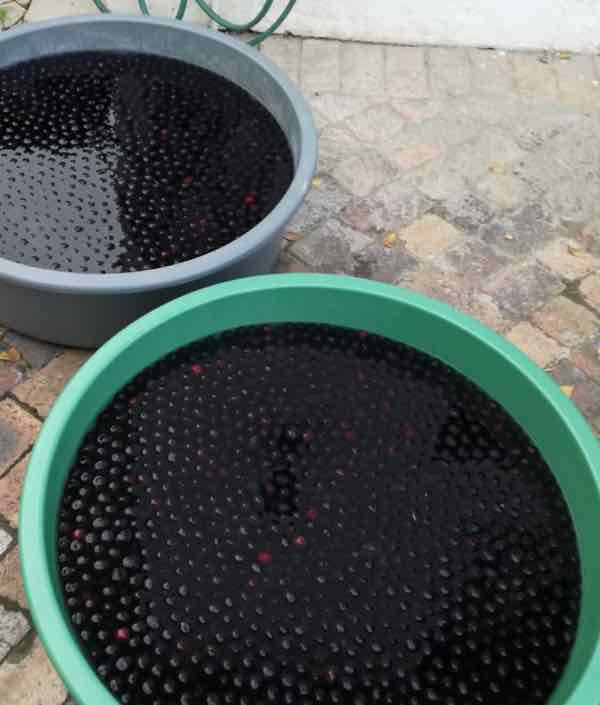
Wash your olives and they definitely must be submerged under fresh-water within 24 hours of harvesting. Discard any that float; or process them separately for a potentially second-grade.
Replace the water after one-day and leave them there for another 24 hours; in full sunshine.
Step 2: 10% brine solution
In a large clean bucket stir 1 kg of table salt into 10 litres of water; within half an hour you will have your ten-percent brine solution ready for the first step of preserving your olives.
Step 3: Examine each olive
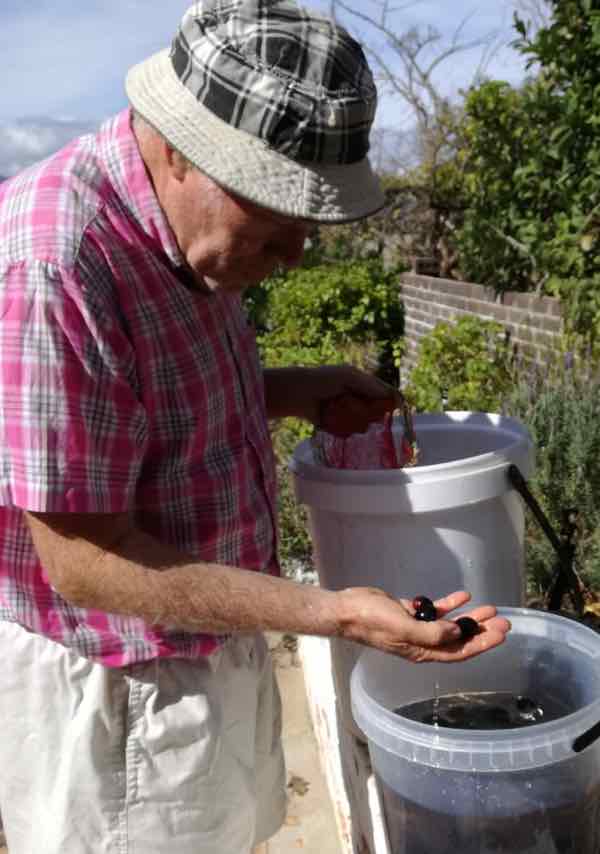
After two days when the olives have been washed and soaked comes the more tedious part of the operation. This is a good activity for the whole-family to get involved in; all those who want to enjoy the fruit.
Those who are conspicuous by their absence may find their plates devoid of olives at lunch-time.
Carefully examine each and every one, removing all stems, and discarding any that are physically damaged or have been stung by insects. Place them in an orange pocket, or something similar.
One damaged-olive can spoil the whole bucket.
The purpose of these bags is simply to make transfer to clean brine much easier; you simply lift it out every two months*, allow it to drip and place it in another bucket filled with a newly made-up solution of salt.
*From 2021 we will do this every six-weeks.
Step 4: Submerge in 10% brine
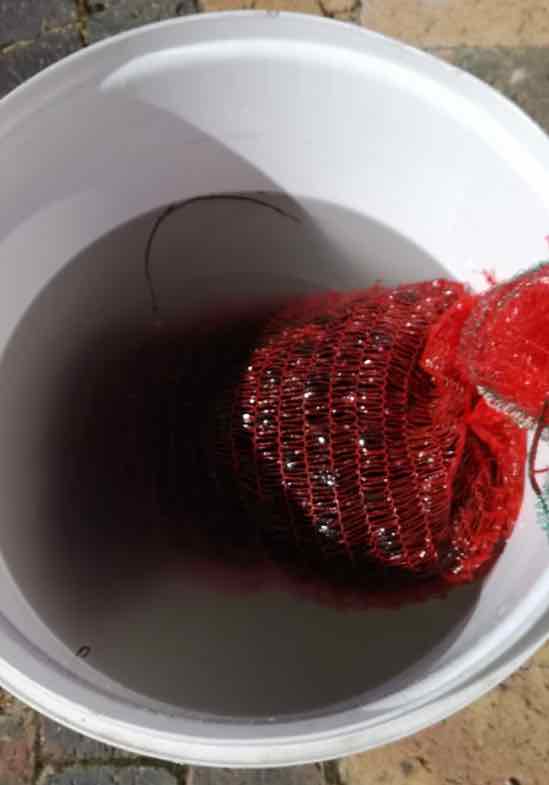
I have been looking forward to this journey of preserving olives for many years, and I hope you will too. We are now about to go into our fourth season. That does not make me an expert but it's not rocket science; all three have been good.
Knot each bag loosely and fit them as tightly as possible in your buckets, keeping the olives submerged in the brine.
I recommend 10-litre buckets as they are easier to lift. Cover the olives you are preserving under a plate to make sure that each and every one remains submerged. Adding a slosh of grape vinegar to limit spoilage is sometimes recommended even at this early-stage.
It is very important that when preserving olives, after reaping, contact with air should be strictly limited; oxygen, heat and light are the great enemies.
Notice the autumn-leaves; fortunately preserving olives is done during the cooler part of the year; they need to be kept under 20°C throughout the process.
More recently we have changed to 25-litre drums with a small opening; they are easier to transport via a courier.
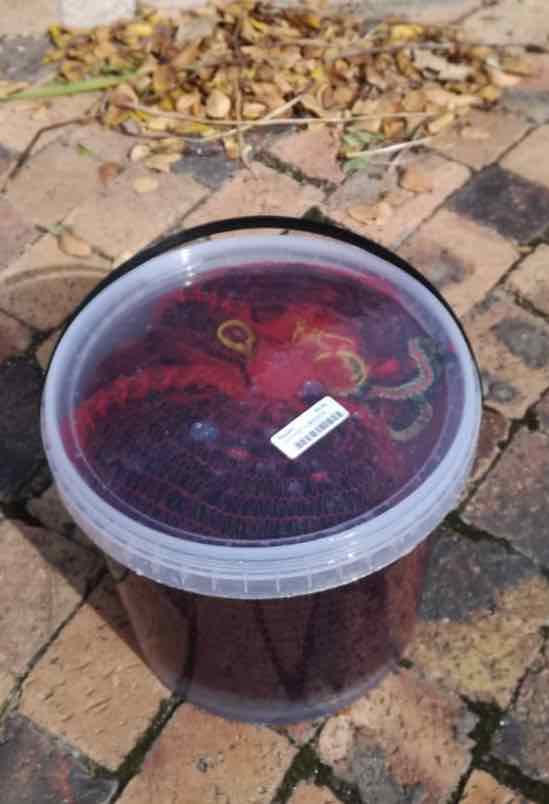
Step 5: Fresh 10% brine
- 1 week
- 2 weeks later
- 2 months later*
- Every two months until they have lost enough of their bitterness for your palate.
* Update November 2020: the olives started going soft us before all the bitterness had been washed out. From next year we are going to try changing the brine every six-weeks. Salt is relatively inexpensive, and the process very simple and quick.
After three-months it is a good idea to check a few olives every few weeks; they can suddenly start going soft.
The olives spend a week in the first 10%-brine and then, according to the schedule above, the bags must be removed from their buckets, allowed to drip, and dropped into a fresh solution of the same concentration.
Again cover with the plate that presses the olives you are preserving down and away from the air; fill the bucket with brine to the very brim so there is no oxygen to spoil them.
How long this process of placing them in fresh brine every two-months will take depends on the cultivar, how ripe the olives were when picked, and even the season. Your personal preference for the level of pungency and bitterness comes into the equation too.
After four-months sample a couple of the olives you are preserving; are they still too bitter? Then they must go for a further period in the brine.
This process can take from 3 to 18 months, but eight seems to be a good average for you to work on.
At the end of every two-month period, you can remove a few olives, place them in a cup of fresh water for 24 hrs and then taste them. If they are still too bitter then they must go back in the brine for a bit longer.
It is normal to find some fungi growing on the surface of the brine during this period; it is no good reason to fuss. Simply lift the olives in bags out of the liquid, allow to drip and put them into a fresh salt-solution with a little vinegar.
Step 6: Wash in fresh water
Preserving olives is an exercise in patience. When you decide they are palatable, place them in a large plastic tray in fresh water, agitating frequently by using a hose and keep washing them to remove as much of the salt as possible, and the last of the bitterness.
Placing them out in the sun will help them regain their dark colour again. Remove any that float or are obviously damaged or have burst.
This washing in fresh water should be for two days.
Step 7: Bottling your olives
The final step of preserving olives is the bottling. These can be as small or large as you prefer.
Pack the washed olives as tightly as possible in your clean glass bottles, or even a large plastic container that you can dip into periodically with a soup ladle.
The pickling liquid is prepared in a large saucepan using a solution of salt and vinegar in water.
Salt (grams)
150
300
600
Vinegar (ml)
150
300
450
Water (litres)
2.5
5
10
This is enough for about 10kg of olives. Use the best quality vinegar
you can find. Next time I am going to try apple cider vinegar or balsamic.
Heat but do not allow the mixture to boil; when it begins to steam pour the hot liquid over the freshly washed olives in jars, or simply in their large buckets, so that they are completely covered.
Add your favourite herbs; it is traditional to use bay leaves, peppercorns, rosemary, basil and chilis.
Once the liquid in your jars has cooled, cover it with a layer of olive oil to seal and keep out any air; tighten the lids.
Preserving olives is a long business which is why they are so expensive; it can take as little as four months, but can take well over a year. With patience, and some sweat off your brow, they will be priced so that you can indulge in half a dozen daily.
Stop the fermentation process
Step 6 is important to stop the fermentation process completely, or your olives will go soft and mushy going into the second year.
When the olives are ready to preserve, after enough 10% salt repeats to remove sufficient of the bitterness to your satisfaction, you have to stop the fermentation by pickling them finally with boiling salt and vinegar, as above, otherwise they will spoil. Then they will last for years.
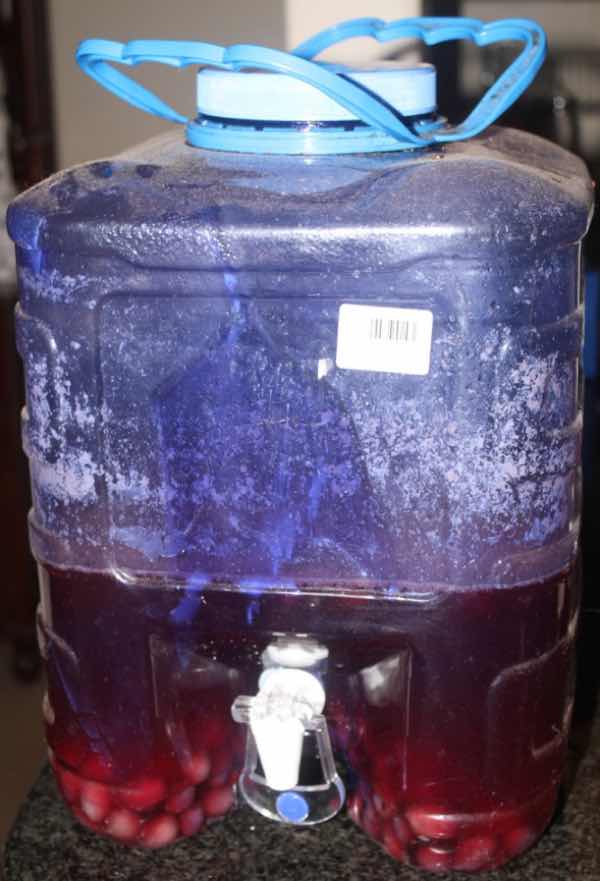
Greek wisdom
A very elderly Greek friend remembers that as a child, once the olives in brine taste right, they would wash them thoroughly to remove as much of the salt as possible, and then lay them out in the sun on a sheet to dry for a day.
Then they would go straight into olive oil, not a brine and vinegar mixture.
That oil, once the olives had been eaten, would be used for frying, and even as a salad dressing.
There are clearly many ways of preserving olives.
Italian wisdom
We have recently had the privilege of a visit from an Italian friend who is very serious about his olives; he says ours at three months taste divine and need no further processing. Leave them in brine and enjoy just as they are.
He admits that he likes them a little bitter, but we would prefer to leave them for another two months in brine.
There are several ways of preserving olives.
Preserving olives
Preserving olives is really only for those who want to enjoy them daily at an affordable price; generally the markup from farmer to retailer is outrageous. I find it interesting that the cost of the olives, from the farmer, is actually less than that of the bottle in which you buy them. It is all about the labour, and of course, time.
Mind you, it has been quite a lot of work, though little expense, and much patience. This is not a process that can be hurried.
Only time will extract the bitterness from the fruit whilst it lies idle in brine.
There is a great taste and wellness to be enjoyed, making it worth all the time and effort.
It is a fun journey, worth taking pleasure in if you are one of those who lives life according to the beat of a different drum.
It is now December, some seven months since the fruit was picked and the process of pickling our olives has began; there is nothing more to be done than periodically scooping them out of the brine and vinegar mixture, rinsing them to get some of the salt out, and we then transfer them to extra virgin oil.
The first batch was a little too bitter for me, though others loved it; these olives are now perfect for my taste buds.
On a mixed green salad with baby tomatoes and feta cheese they make the perfect Greek salad.
I call it Helen's fifteen euro salad actually, first made in Holland and now in Hilton. Preserving olives has become part of the ritual.
Pit olives
Learning how to pit olives is one of those skills that everyone coming from the Mediterranean will know; we should all learn it. It is so simple and might save you from a costly consultation with your dentist.
Schedule 2019
(they are ready and I will now move to step 6) |
|
The three-month change of the brine is now complete and it was really very quick. The longest part was waiting for the salt to dissolve in the hot water.
I use the cheapest that is available; not the coarse.
Not losing count and making sure that you have added ten litres of water to 1kg of the mineral is the most difficult part.
One little benefit for this gardener is that plants do not like brine. I hate using Roundup; all the suggestions are that it is really toxic and perhaps causes lymphoma, though the American courts have as usual gone totally overboard.
Salt water from preserving olives, poured onto the pesky little weeds that come up in the driveway has proved amazingly effective.
The olives incidentally, even at this early stage, tasted amazingly good. I reckon in another two months we will probably start enjoying them.
Update
It is now August, 2019 and we are enjoying our olives. There are many thoughts and plans on how preserving olives should proceed.
It is now September and the olives have lost their bitterness and have gone a little soft. It is time for bottling to stop the fermentation; in fact I should probably have done it a month ago.
Schedule 2020
In 2020 we are trying something a little different but the courier let us down. It took them a whole month to get them to our small village in Hilton on the opposite side of South Africa. So instead of a week later, it took four to make the first change of the brine; time will tell how serious this has been. Later we found that they went soft before losing all their bitterness; preserving olives has its difficulties.
And instead of buckets, using bags for easy change of the brine, we are going into 25 litre drums. Getting the olives into the mouth was a little troublesome with a make-shift funnel, but changing the liquid will be a lot easier. We will update as we go along.
These olives came from a Stellenbosch farm, were rather cheaper at R20/kg, but it is much cooler than the Little Karoo and they ripened a whole month later; June instead of May. Another preserving olives journey has begun. It is going to be an annual ritual.
- Pick olives
- Wash 1
- Wash 2
- Brine 0
- Brine 1mth later
- Brine 2wk later
- Brine 2 mo later
- Brine 4 mos
- Brine 6 mos
- Brine 8 mos
- 10 June, 2020
- 10 June
- 11 June
- 12 June
- 11 July
- 25 July
- 25 August - still a touch bitter, another month.
- 27 September - still a touch bitter.
- 27 October - ahgg, they've started going soft and still rather bitter. Final step, near boiling brine and vinegar. Next year will change brine at 6 week intervals. Still, they are very nice.
Salt
One other good reason for preserving olives is to reduce the salt content at the final stage before eating by rinsing several times with fresh water.
According to SFGATE[2] each black olive contains about 32 mg of sodium. I like to have about 10 with my lunch every day, totally 320 milligrams, more than 10% of the recommended 2,300 mg recommended per day. Exceeding this raises the risk of hypertension and cardiovascular disease.
So now before enjoying our olives we submerge them in fresh water for a two days, before again putting them in clean bottles with garlic, peppadews and bay leaves with a teaspoon of vinegar but no saline; low sodium.
There is no doubt about it, the strong salt taste is substantially reduced; my guess is that it is a half or less. It is just one more good reason for preserving olives.
Now those ten olives have perhaps only 150 mg of sodium, or less than a tenth of a teaspoon of salt. That's the difference between a preserved food that is less than good for your well-being to one that is rich in the excellent oils, phenols and fibre and will promote longevity.
If you like olives, start to think about preserving your own; I'm sold on it.
Measuring out a 10% solution is easy with two five-litre water bottles; just split 1kg if salt between them, roughly in halves, or weigh it to be more exact.
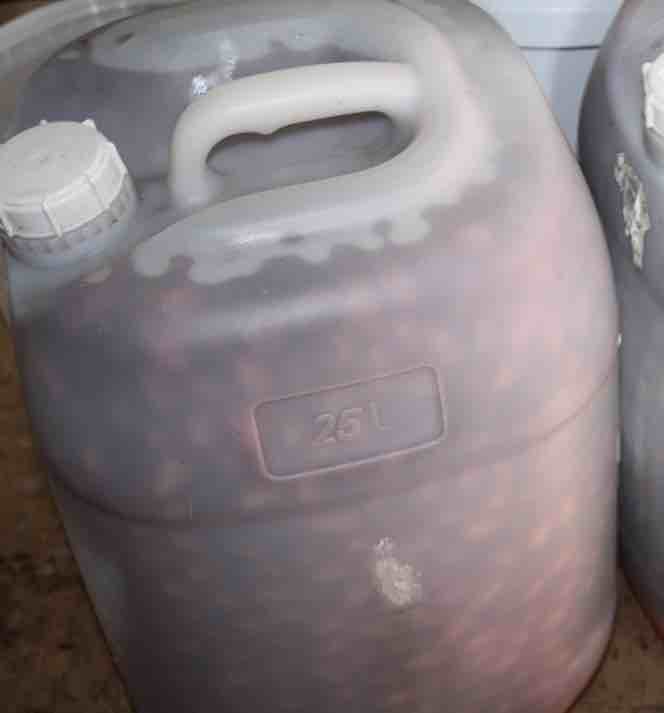
As a rough guide, a 25-litre container will take about 12kg of olives, and need about 1200 ml of brine.
Schedule 2021
2021 has been a disaster for farmers in the Western Cape growing Mission olives; heavy winds whilst the trees were in blossom played havoc. Consequently we have had to turn to a softer variety, the Calamata; it's quite different.
We received our consignment of 40kg, all that was available in early May; they came in a 10% brine solution. The proposed schedule by my guru, a man of 20-years experience in preserving olives but admitted he was new to Calamata, is as follows.
- Olives harvested
- Wash 1
- Wash 2
- Brine 0
- Brine + 1/2 cup vinegar 1 wk later
- Brine + 1/2 cup vinegar 2 wks later
- Pickle half the olives one-month later
- The unpickled half remain magnificent with no softening of the olives.
- 1st May, 2021
- 2nd May
- 3rd May
- 3rd May
- 10th May
- 24th May
- 24th June
- 19 th November
The olives are huge and plump, beautiful looking, but concerns that they are already a bit soft, yet bitter. I can see the Calamata are a whole different ballgame. They will be ready to eat much sooner.
And perhaps they will be too soft; by the end of June we will know.
Vitamin E
Vitamin E is one of the more difficult essential phytochemicals to get sufficient of in the diet since the refining of wheat to make flour began some 200 years ago; all the oil is removed. And olives are a rich source too.
One olive weighs about 5 grams, so my 10 that I enjoy for lunch might be as much as 50g.
According to Medical News Today[3], 50g of olives contain 0.8 mg of vitamin E; that is more than 5% of the RDA which is 15 mg per day. One really needs 100% real bread to get sufficient.
When deficient, vitamin E is one of the four found to lead to premature frailty.
The more I think about it, the greater the need of preserving olives becomes to me.
Olive oil
Once you have opened a bottle of olive oil, enjoy and finish it within a few weeks; oxygen, light and heat are the great enemies. Unopened it will be fine for up to two years; perhaps.
Once it gets the taste of rancid nuts it is becomes horrible; unlike wine, it does not improve with age.
Beware in 2020 because the coronavirus epidemic has caused chaos in the industry. With the collapse of tourism, olive oil prices have dropped dramatically, and worse is that a huge surplus of 2019 of Spanish olive oil is flooding the Italian market and being labelled as Italian olive oil. Manufacturers the world over in virtually every product suck with their lies and deceit[1].
The only way to be sure of the food you are getting, be it olives, honey and vegetables is to find small farmers who will market their products directly to you. If you value the taste and nutrition of good food and want to live long in the land, it is worth the time and effort.
Preserving olives is one way to ensure longevity.
Olive dishes
Olives lend themselves to so many different side-dishes. You can add lemon juice or chilies; and some folk like garlic. Then you can use many different spices such fennel seeds and feta cheese for a tapenade. The sky is the limit.
This easy spicy olives dish is a very simple favourite; just five-minutes work.
When browsing use right click and Open Link in New Tab, or you may get a bad gateway signal.
Newsletter
Our newsletter is entitled "create a cyan zone" at your home, preserving both yourself and Mother Earth for future generations; and the family too, of course. We promise not to spam you with daily emails promoting various products. You may get an occasional nudge to buy one of my books.
Here are the back issues.
- Lifestyle and ideal body weight
- What are ultra-processed foods?
- Investing in long-term health
- Diseases from plastic exposure
- Intensive lifestyle management for obesity has limited value
- A world largely devoid of Parkinson's Disease
- The impact of friendly bacteria in the tum on the prevention of cancer
- There's a hole in the bucket
- Everyone is talking about weight loss drugs
- Pull the sweet tooth
- If you suffer from heartburn plant a susu
- Refined maize meal and stunting
- Should agriculture and industry get priority for water and electricity?
- Nature is calling
- Mill your own flour
- Bake your own sourdough bread
- Microplastics from our water
- Alternative types of water storage
- Wear your clothes out
- Comfort foods
- Create a bee-friendly environment
- Go to bed slightly hungry
- Keep bees
- Blue zone folk are religious
- Reduce plastic waste
- Family is important
- What can go in compost?
- Grow broad beans for longevity
- Harvest and store sunshine
- Blue zone exercise
- Harvest and store your rainwater
- Create a cyan zone at your home
Did you find this page interesting? How about forwarding it to a friendly book or food junkie? Better still, a social media tick would help.
- Bernard Preston homepage
- Olives
Address:
56 Groenekloof Rd,
Hilton, KZN
South Africa
Website:
https://www.bernard-preston.com